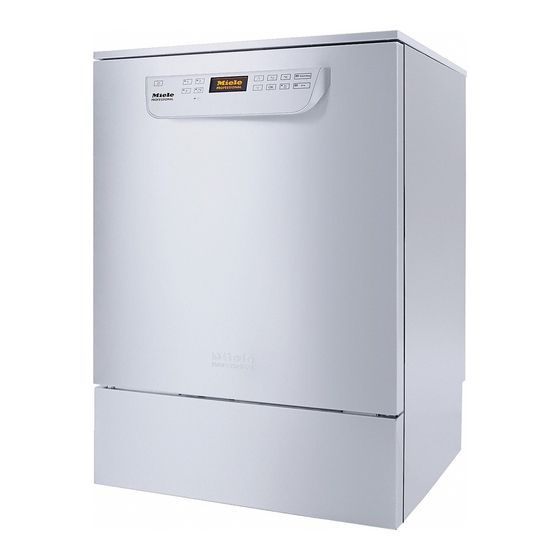Miele PG 8581 Supplementary Document - Page 5
Browse online or download pdf Supplementary Document for Washer Miele PG 8581. Miele PG 8581 40 pages. Washer disinfector

2.4. Warning & Safety Instructions
•
The standard of cleaning and disinfection in the
disinfection programmes must be routinely confirmed by
the user.
•
Make sure items being washed are suitable for machine
reprocessing and are in good condition. Plastic items
must be thermally stable. Nickel plated items and
aluminium items can be machine processed using
special procedures only.
Items containing iron, and soiling containing residual rust
must not be placed in the cabinet.
•
Instrument care products based on paraffin oils (white
oils) can damage the elastomers and plastic in the
machine. Such care products must not be dispensed
as chemical agents in this machine, even if they are
recommended for machine use by the care product
manufacturer.
•
Abrasive substances (e.g. prophy paste) must not be
placed in the machine as they will cause damage to
the mechanical components of the water circulation
system. Any residues of abrasive substances on items
to be washed must be removed without trace before
reprocessing in the machine. We recommend using
Eschmann recommended wipes at the point of use to
remove these residues.
•
Cements used at the chairside must be wiped away
immediately after their application to protect the
instrument and to ensure effective cleaning in the
washer disinfector. We recommend using Eschmann
recommended wipes at the point of use to remove these
residues.
•
Pre-treatment with chemical agents can create foam, as
can certain types of soiling. Foam can have an adverse
effect on the disinfection and cleaning result and may
lead to machine issues.
•
Processes must be set up such that foam or chemicals
that can create foam do not enter the wash cabinet. It
would hinder the correct functioning of the machine.
•
The process used must be monitored on a regular basis
by the supervisor to check foaming levels.
•
Where a chemical is recommended on technical
application grounds (e.g. a cleaning agent), this does
not imply that the manufacturer of the machine accepts
liability for the effect of the chemical on the items being
cleaned.
Please be aware that changes in formulation, storage
conditions etc. which may not be publicised by the
chemical manufacturer, can have a negative effect on the
cleaning result.
•
When using a chemical agent it is essential that the
manufacturer's instructions are followed. The chemical
agent must only be used for the application it is
designed for and in the situation specified, to avoid
material damage and such dangers as a severe explosive
chemical reaction (e.g. an explosive oxyhydrogen gas
reaction).
•
Always follow the relevant manufacturer's instructions on
storage and disposal of chemical agents.
•
In critical applications where very stringent requirements
have to be met, it is strongly recommended that all the
MUW216743-2
relevant factors for the process, such as chemical agents,
water quality etc. are discussed with Eschmann.
•
Baskets and carriers should only be used for the
purpose they are designed for. Hollow items must be
thoroughly cleaned, internally and externally.
•
Secure small and light items in a mesh tray meant for
small items, so that they do not block the spray arms.
•
Empty any liquid and/or paste from containers or
utensils before loading them.
•
The amount of residual solvents and acids on items
going into the cabinet should be minimal.
There should be no more than a trace of any solvents
with a flash point of below 21°C.
•
Chloride solutions, in particular hydrochloric acid, must
not be placed in the cabinet.
•
Ensure that solutions or steam containing chlorides or
hydrochloric acid do not come into contact with the
stainless steel outer casing of the machine in order to
avoid any damage through corrosion.
5
